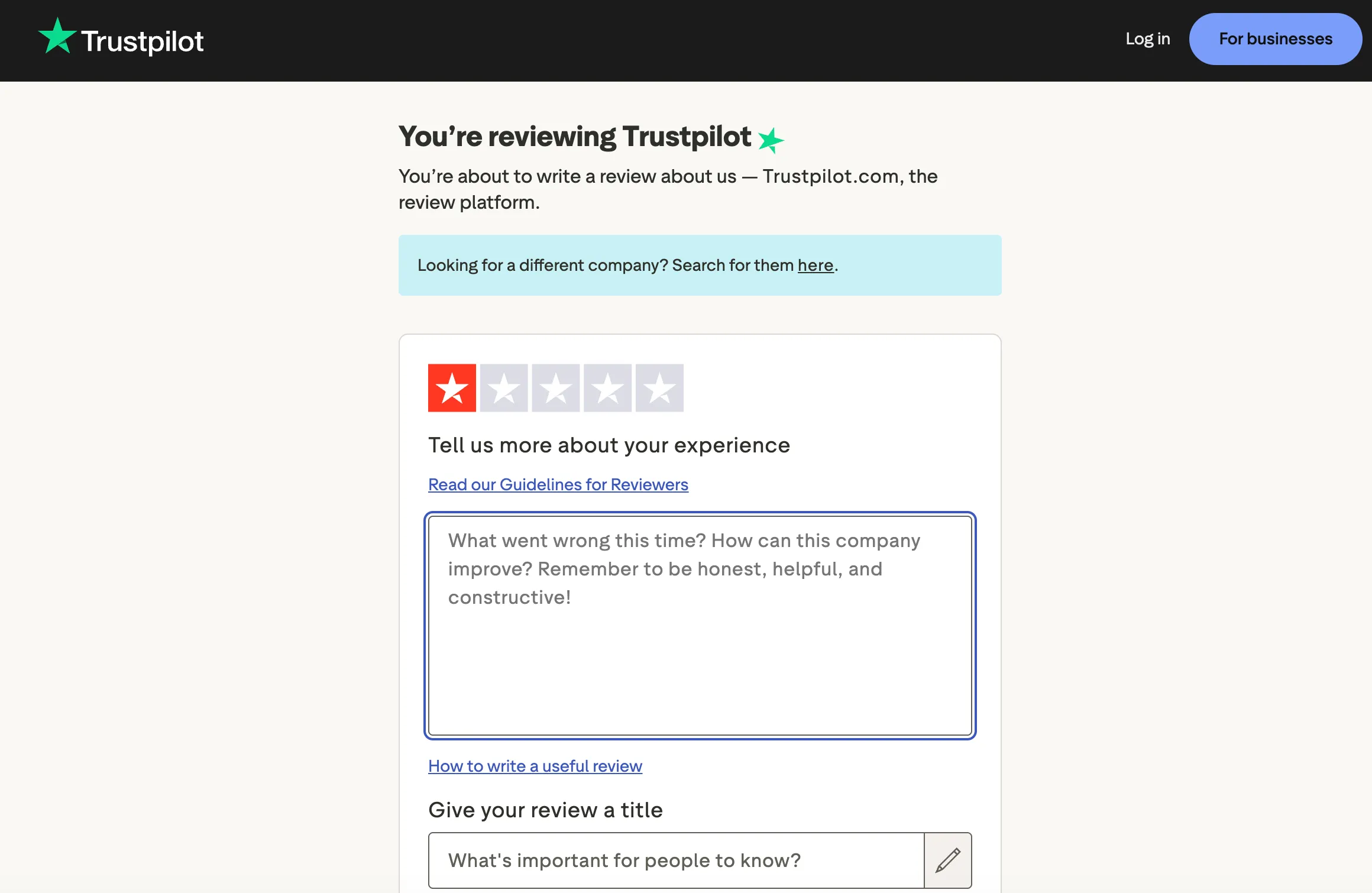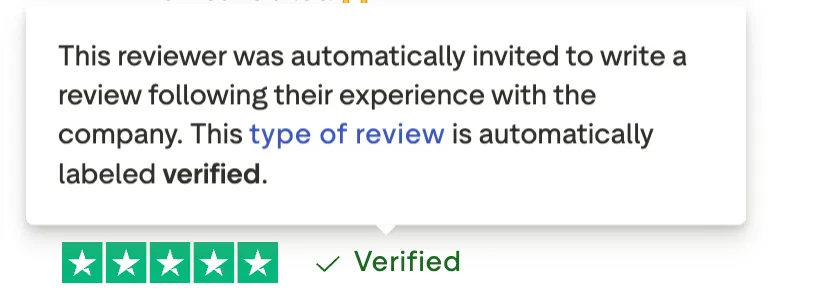Don't Fall into TrustPilot's Trap
How It Started
The company received feedback from B2B sales that the brand’s TrustPilot score was only 3/5, with many negative reviews, which was starting to affect brand image and closing rates.
How to solve it? The most direct approach was to go the official route: use TrustPilot’s Shopify App to invite past customers to leave reviews, and use positive reviews to boost the score. Sounds reasonable, right?
So that’s what we did. And then we fell into a trap.
TrustPilot’s Pricing Trap
We use Shopify, and TrustPilot has a plugin that can automatically invite users to review after orders are completed. The company’s thinking at the time was simple:
Staged Strategy:
- First subscribe to the Advanced plan ($1,099/month), with a large quota, to invite a large number of users at once to boost ratings.
- After the rating goes up, downgrade to the Plus plan ($299/month) to maintain it.
- After stabilization, switch to the free plan. Perfect.
The ideal was plump, but reality slapped us in the face. First, let’s look at this company’s pricing:
| Plan | Price | Core Features |
|---|---|---|
| Plus | From $299/month | Review tools · Remove third-party ads · Marketing widgets · Performance insights |
| Premium | From $629/month | Advanced analytics · Predict TrustScore · Social assets · Competitive benchmarking · API* |
| Advanced | From $1,099/month | Custom analytics · Precision widgets · Brand design · Market assessment · Salesforce/API |
| Enterprise | Custom pricing | AI tools · Full API · Scale management · Visitor insights · Data reports |
*Note: The API interface marked in the Premium plan is not actually included. API requires additional payment, and sales will price based on your website’s SEMRush traffic. See how greedy they are!
Rogue Terms: The One-Year Contract Trap
Here’s where it gets awkward.
Subscribing was smooth as butter, card linked in seconds. But when we wanted to downgrade, the company’s true colors showed:
“The contract is signed annually, just billed monthly. We don’t accept cancellation or downgrade because you agreed to our terms when you made the payment.”
It was truly frustrating to hear this, because what SaaS today isn’t billed and serviced monthly? Even worse, if you don’t continue paying, they threaten to transfer the bill to a third-party collection agency.
Their Business Model Is Essentially Extortion
Thinking about it carefully, this routine is too disgusting:
- Passive negative review mechanism: Only dissatisfied users will actively find channels to complain and leave negative reviews, satisfied customers won’t even think about going to TrustPilot.
- Hostage-style charging: Want to improve your rating? Pay annually, no negotiation.
- Exit penalty: Want to exit mid-term? Sorry, contract period not completed, don’t pay and we’ll send it to collections.
For large companies, this amount of money might just be pocket change for the marketing department. But for small and medium-sized businesses? This is blatant robbery.
Reddit is full of small business owners complaining about this [1] [2]

The Truth About Sales Pitches
Many people are fooled by their sales, who constantly emphasize TrustPilot’s SEO benefits. Actually, it’s not important at all.
You can try searching for brand names you’re interested in. As long as your content isn’t particularly scarce, TrustPilot pages won’t even make it to the first page of search results. As a consumer, would you really go to TrustPilot specifically to check a brand? I certainly wouldn’t - I’d reference the ratings and reviews on the website itself.
So TrustPilot really isn’t useful for promoting brand image and growth.
If You’ve Already Fallen Into the Trap
If you’ve unfortunately already subscribed and want to cut losses before the contract expires, you can try the following methods to escape.
Here are the steps we’ve personally practiced:
- Cut off the funding source: Contact your bank to freeze the credit card currently linked to your TrustPilot account.
- Formally request termination: Formally contact TrustPilot customer service via email, inform them in writing that you will no longer pay subsequent fees, and request immediate cancellation of service. Keep all communication records as evidence.
- Patiently wait and ignore collections: After stopping payment, TrustPilot will continue to generate subscription bills and keep collecting payments, while threatening to transfer the bill to a collection agency. After about 3 months of unpaid bills, they will transfer your “debt” to a third-party Debt Collection Agency. After that, you’ll receive collection emails from the third-party agency - just stay calm.
- Negotiate directly with them: When you receive emails from the collection agency, do not communicate with them. At this point, control is back in your hands. Contact TrustPilot’s billing department directly and propose a settlement: you’re willing to pay the current outstanding balance (for example, 3 months of fees), on the condition that they immediately terminate the entire annual contract.
Through this method, we ultimately only paid a small portion of the fees and successfully escaped the subscription trap of nearly $10,000 for the remaining nine months.
How to Improve Your Rating Without Spending a Dime
According to TrustPilot’s own so-called “transparency” terms, once your brand homepage is created, you can forget about taking it down. It will hang there forever, whether you pay or not.
So, is there a way to improve your rating without paying them “protection money”?
Of course there is, and the method is surprisingly simple.
The core principle is simple: TrustPilot’s paid service is essentially just an expensive email automation tool. We can completely bypass it and do the invitation ourselves.
Step 1: Get Your Exclusive Invitation Link
This is the most critical part of the entire solution. You need a link that can guide users directly to your brand review page. Format:
https://www.trustpilot.com/evaluate/trustpilot.com
// Replace trustpilot.com with your own brand profile URLThis link has exactly the same function as the one in their official paid emails. After clicking, users will directly enter this review interface:

Step 2: Send Invitation Emails Yourself
After getting the link, you can send invitations to customers by writing a review invitation email through your existing tools:
- Shopify merchants: Can directly use the Shopify Email app, filter historical customers, and send invitation emails in batches. Furthermore, you can use Shopify Flow to set up automated processes to send them on a schedule after order completion.
- Merchants on other platforms: Same principle. Export your customer email list and use Mailchimp, Listmonk, or any email marketing tool you’re familiar with to send in batches.
What’s the Difference from the Official Solution?
The only difference is that reviews submitted through our own link will lack a ”✅ Verified” badge.
- Official paid solution: Reviews will have a ”✅ Verified” badge, meaning “invited through TrustPilot’s official system.”
- Our free solution: Reviews don’t have this badge.
But the key point is: this badge doesn’t affect your final score at all. Whether it has it or not, a five-star positive review is a five-star positive review.

It’s that simple. Perfectly save $13,188 per year in subscription fees, with zero limits on review invitation sends.
For Those Still Watching: Don’t Use TrustPilot
If you’re selling physical products, TrustPilot really isn’t useful for you.
Their value mainly shows in the external promotion of large service companies, as an “authoritative certification” badge. For small and medium-sized businesses or e-commerce? Very low cost-effectiveness.
Better Alternatives
If you use Shopify:
- Use third-party plugins like Judge.me or Loox to build your own review system.
- Connect review data to Google Merchant Center.
- Let your product ratings display in Google Shopping.
Why is this better?
- Google Shopping ratings have much more impact on SEO, SEM, and conversion rates than TrustPilot.
- Consumers actually see and reference ratings on Google.
- TrustPilot? Few people care.
See the image below, this is truly useful rating display:

Final Words - TrustPilot’s Business
TrustPilot’s business model is essentially collecting “digital protection money”, and they do it extremely ungracefully.
Their routine is like this: First, without your knowledge, they set up a target for you online, then let the most unhappy customers go up and fire at will. Because they know very well that satisfied customers are too lazy to speak up, only those who are pissed off will look everywhere for places to complain.
When you get covered in shit and your rating turns into a pile of crap, their sales come along, pretending to hand over the only “antidote” - a ridiculously expensive annual package, and they lock you in with a rogue contract.
Why Do I Hate This Company So Much?
Because it’s not doing any legitimate business at all. It’s holding your brand reputation hostage and forcing you to pay ransom annually.
This business model is fundamentally bad. It doesn’t make money by creating value, but by creating trouble and selling anxiety to extort and blackmail. This practice of putting a knife to small businesses’ throats is truly disgusting.
Comments